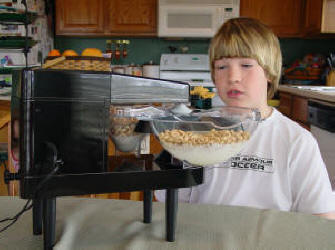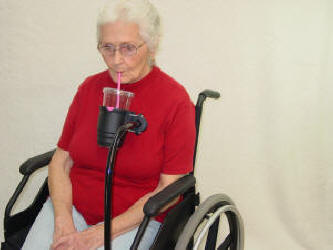Mealtime Partners, Inc.
Specializing in Assistive Dining and Drinking Equipment
August 2021 Independent Eating and Drinking Newsletter

|
August Topics:
|
||
|
Mealtime Partners Home Page Send a Comment or Suggestion |
|||
| Subscribe to Newsletters, or Unsubscribe from Newsletters |
The heat has been extreme in many parts of the world this summer. With soaring temperatures and high humidity it is more important than ever to keep well hydrated. When the body is in an ideal state of hydration (the water is exactly balanced, not too much or too little) it is known as being in a state of euhydration. When the body has excess fluid in it, it is known as hyperhydration and when it has too low in fluid it is known at hypohydration which is more commonly referred to as dehydration. Some scientists refer to dehydration as the body loosing water while hypohydration is the state of the body when it has a water deficit. The question arises, what should we drink to maintain our bodies in a well hydrated state?
Researchers at Loughborough University in the United Kingdom have conducted research with the goal of creating a Beverage Hydration Index (BHI). The BHI would identify fluid retention in the body of beverages and how the beverage maintains fluid balance in the body. The researchers felt that this information could be of value when access to fluids is limited and also when it would be inconvenient to stop to urinate. These factors are impacted by the volume of beverage consumed, its energy concentration, the electrolytes in it, and its diuretic content (alcohol, and caffeine). Plain water was the baseline that all other beverages were compared to in the study. Other beverages included in the study were: sparkling water (Highland Springs); cola (Coca-Cola); diet cola (Diet Coke); sports drink (Powerade); oral rehydration solution (ORS)1 (Dioralyte; Sanofi); orange juice (Tesco Everyday Value); Lager beer (Carling); hot black coffee (Nescafe Original); hot black tea (PG Tips); cold black tea (PG Tips); full-fat milk (3.6% fat; Tesco); skimmed milk ( 0.1% fat; Tesco).
For each trial in the study, participants drank one liter of one of the liquids described above, over a period of 30 minutes, and urine was collected for the following 4 hours. Throughout the study the volume of all of the liquids consumed was the same even though the water content of the test drinks varied because of a difference in nutrient contents, macronutrients, electrolytes, and diuretics in the assorted drinks. When the data was adjusted to account for the difference in water content of the drinks it was found that ORS1, full-fat milk and skimmed milk were retained by the body at a higher level than plain water and the other drinks included in the study. The study found that drinks that contained energy producing contents remained in the stomach longer than those that did not. Even though urine was collected for 4 hours after the end of the consumption period, it was found that after 2 hours, the differences in the various drinks showed in the urine output. Also, the majority of urine was passed in the first 2 hours after it was drunk. Additionally, most people do not go without a drink for longer than 2 hours.
Other studies have examined the impact of various drinks on fluid retention and found no significant different in fluid retention, regardless of what specifically was drunk, over a 24 hour period. Most importantly the volume of liquid consumed, rather than what was actually drunk, impacted the level of hydration.
Even though drinking water is encouraged for both hydration and general good health, research appears to indicate that as long as individuals drink an adequate volume of liquid, what they choose to drink is less important than how much they drink.
Note: (1) According to The National Cancer Institute, Oral rehydration solution is an aqueous solution composed of glucose and electrolytes, including sodium, potassium, chloride, magnesium, and phosphorus, with dehydration preventative and rehydration activities. Upon oral administration of the oral rehydration solution (ORS), water, electrolytes and glucose are absorbed from the gastrointestinal (GI) tract into the systemic circulation. This replenishes the body's supply of water, carbohydrates and electrolytes, and prevents both dehydration and renal dysfunction.
|
Whether it is eating or drinking Mealtime Partners has a HANDS-FREE solution to independence |
|
 |
 |
| The Mealtime Partner Dining System on Legs | The Front Mounted Drinking System |
|
Independent eating, whether it is accomplished in the traditional way, using your hands, or using assistive technology, allows you to select the order in which the various foods that are being served are eaten, and also the pace at which each bite is eaten. Thus, meats can be chewed for however long it takes to break the bite into particles that are easy to swallow, while the soft food, like pudding, can be swallowed quite rapidly. The Mealtime Partner Dining System allows those individuals who cannot feed themselves using their hands and a utensil, to be able to control their mealtime completely. They can change the pace of eating to accommodate the textures of food that are being eaten, and also to pause to interact with other diners. Additionally, plenty of water should be consumed, all day long. For those individuals who are unable to pick up a cup, maintaining healthful consumption of liquids can be difficult. Mealtime Partners products provide a solution. For more information about our drinking products, please visit the Drinking Products page on the Mealtime Partners website. |
|
| For more information about the most flexible assistive dining system available, please visit: The Mealtime Partner Dining Device Description webpage, or call us at 800-996-8607. | |
What is Dysphagia? A Brief Overview
The word “Dysphagia” comes from the Greek word dys that means difficulty or disordered, and phagia that means to eat. The American Speech-Language-Hearing Association (ASHA) defines dysphagia as “a swallowing disorder”. According to ASHA, the signs and symptoms of dysphagia may involve the mouth, pharynx, larynx, and/or esophagus. ASHA documents have adopted “swallowing and feeding disorders” as the more inclusive phrase for dysphagia. Dysphagia is a swallowing disorder and should be differentiated from difficulties getting food to the mouth that is a feeding disorder. Dysphagia can affect people of all ages but its incidence increases as people age and may be as high as 22% in people over 50 years of age. An estimated 15 million people in the United States are affected by dysphagia.
Some of the indicators that an individual may have dysphagia are a constant clearing of the throat or coughing; a sore throat; chronic heartburn; difficulty swallowing; choking or breathing saliva into the lungs; liquids coming through the nose; a horse or weak voice; a “rattling” sound coming from the chest; and weight loss.
Dysphagia can have many different causes that can be broken down into the following general categories:
Neurological Disorders such as stokes, traumatic brain injury, Huntington’s Disease, Multiple Sclerosis (MS), Amyotrophic Lateral Sclerosis (ALS), and Cerebral Palsy (CP).
Obstructive Lesions that can include cancer of the head and/or neck, and of the esophagus; scarring of the esophagus most commonly caused by gastric esophageal reflux disease (GERD), and, birth defects.
Muscle Function and Connective Tissue Disorders including muscular dystrophy (MD), myasthenia gravis, and Sjogren’s syndrome (www.sjogrens.org).
Swallowing, either while eating or drinking, is a complex function that takes the interplay of approximately 50 pairs of muscles and nerves. It only takes a small interference with this interplay to cause swallowing difficulties. Esophageal dysphagia creates the feeling of something getting stuck in your throat or chest. It can be caused by the failure to open of the valve that opens and closes to allow food to enter the stomach (i.e., lower esophageal sphincter or LES), or by an obstruction. The problem tends to worsen over time. Oropharyngeal dysphagia occurs when the muscles and nerves in the throat are weak, which creates difficulties moving food from the mouth into the throat and esophagus. It can cause gagging or choking when a swallow is attempted. Also, fluids may go into the windpipe or up into the nose. It can also lead to pneumonia.
Even though people of all ages are impacted by dysphagia it is most commonly associated with the very young and the elderly. It is responsible for an increase in mortality rates for everyone affected by it and can lead to starvation and dehydration. Swallowing problems significantly reduce the quality of life of someone affected by them.
For children, especially those born prematurely, an inability to properly coordinate the suck, swallow and breathing function necessary to drink can cause gagging, choking and regurgitating. Regurgitating can irritate the esophagus and make eating a painful experience for an infant. The result can be a resistance to eating because of the pain associated with the experience. Failure to thrive can be the result of this type of problem in infants. For babies with neurological impairments the neuromuscular coordination of the oral motor muscles may be deficient or immature and cause an increase in gastroesophageal reflux. In either case the result of dysphagia can be aspiration.
As people age, their risk of developing dysphagia increases. This may be because the onset of several diseases linked to dysphagia are associated with getting older, and/or that muscles associated with swallowing deteriorate as we age. Age-related deterioration of the orophanyngeal phase of swallowing is well documented and is frequently due to irreparable neuromuscular disease.
It is noteworthy that the elderly sometimes avoid taking medicine because swallowing pills is difficult or because the medication remains in their mouth for an extended time. In addition, some medications can worsen the occurrence of swallowing problems because they produce a dry mouth which makes eating and swallowing more difficult.
Treatment for dysphagia can be as straightforward as changes to the food and liquid consumed; its texture and/or thickness. Adjustments to the individual’s positioning while eating and having them remain in a sitting position after eating can help. Medication can be very beneficial in some cases. Also, therapy to make the muscles of the mouth stronger or to increase the tongue movement and improve chewing may help reduce dysphagia. The appropriate treatment will be developed by a physician (possibly in association with a speech pathologist) after a thorough medical examination and an understanding of the person’s history relating to health and swallowing is acquired.
| Did You Know? Did you know that The American Rescue Plan Elementary and Secondary Emergency Relief Fund were enacted into law in March, 2021. The education section of the Act is intended to help students regain learning losses that developed during the Covid-19 pandemic when they learned from home, rather than attending school in person. It will provide schools with approximately $110 billion which is intended to be spent before March 2023. $22 billion is to be spent directly on student learning loss and the remaining funds can be spent to accommodate schools specific needs. According to research conducted by Accenture, and published by Easter Seals, 93% of children with severe disabilities have not met milestones during the Covid-19 pandemic. In many cases assistive technology can enable children to learn and function more easily. The money from this Act can be used to help students with disabilities receive equipment that will help them reach milestones that have been missed during the pandemic. Schools should be aware that funding is available and facilitate children in their special education programs to receive the appropriate equipment to help them regain the ground that they have lost during the pandemic. |
To subscribe to the Mealtime Partners Newsletters, click here.
Mealtime Partners Website Navigation:
Home | Dining | Drinking | Videos | All Products | Warranty | Ordering | Calendar | FAQ | Newsletters | Contact
Please send comments and suggestions to newsletters@mealtimepartners.com
Copyright © Mealtime Partners, Inc. 2021
All rights reserved.